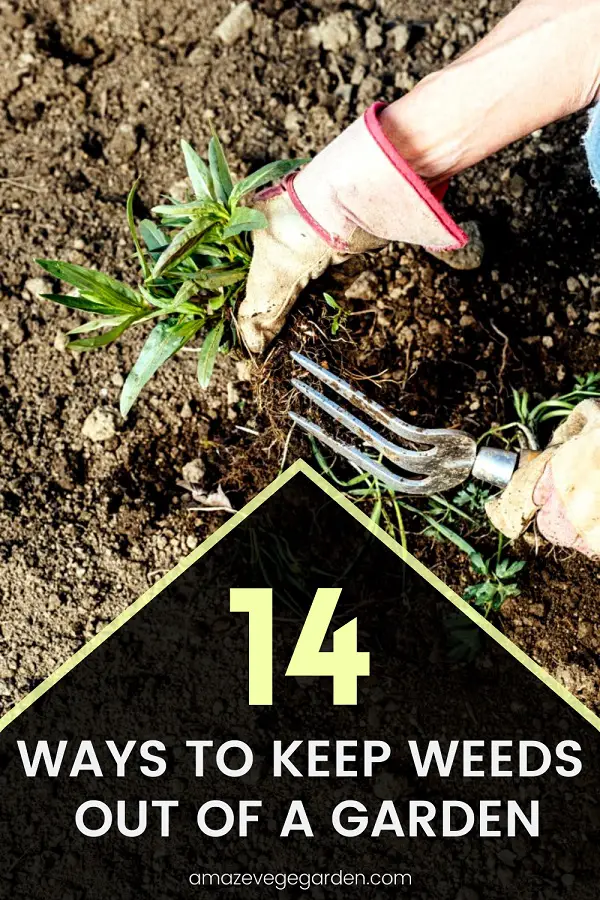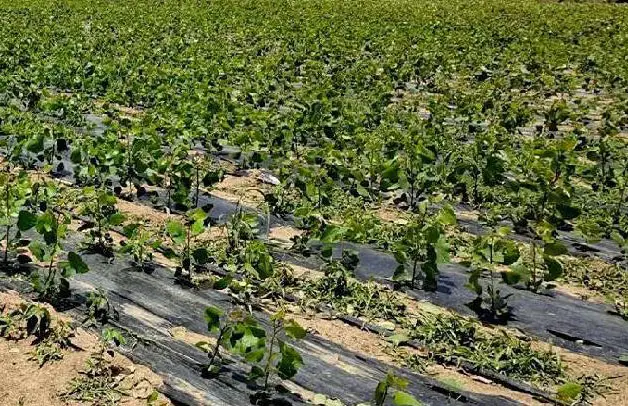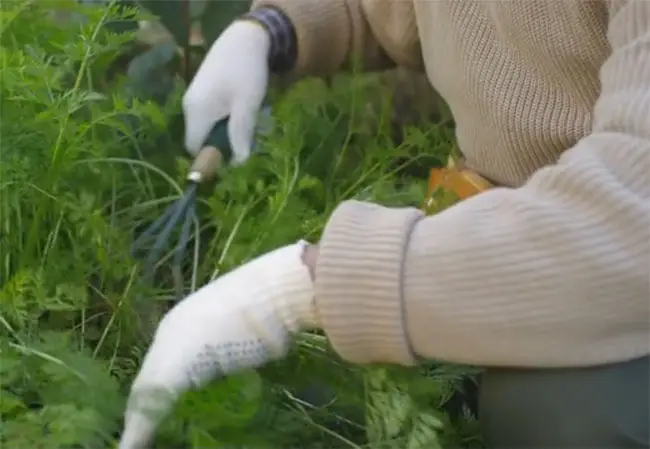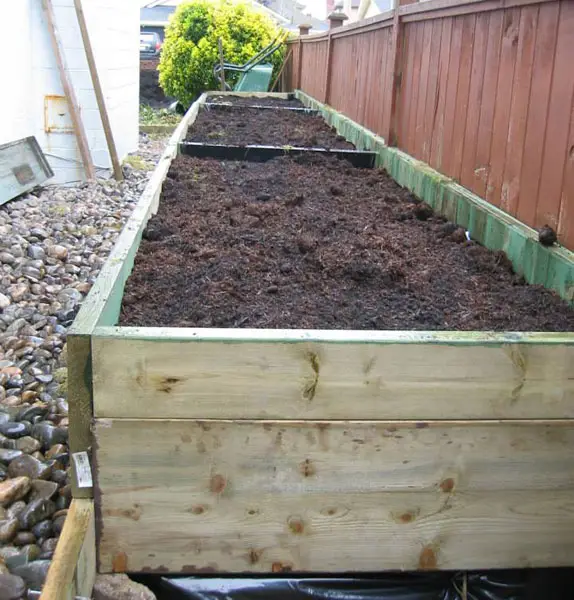Fighting weeds is one of the hardest things about being a gardener since the conditions that your garden plants like are conditions that weeds like too. As a result, gardeners have worked for centuries on different methods to try and keep weeds out of the garden for good.
Below you’ll find twenty-five different ways you can work to keep weeds out of the garden, your lawn, your vegetables, and your landscaping borders. While commercial weed killers are arguably effective, they can also damage the environment and the plants you’re trying to grow. The methods below offer some environmentally friendly ways to kill weeds for good.
Invest in a Weed Barrier
Weed barriers (also known as landscaping fabric) are a useful investment if you’re putting in new vegetable beds or landscaping borders. Weed barriers are usually used in perennial beds where the soil isn’t tilled every year, making them popular in borders.
While weed barriers will prevent many weed seedlings from sprouting in your bed, there are advantages and disadvantages to using weed barriers to keep weeds out of the garden. This is a weed prevention method that doesn’t work for all areas of the garden.
The major disadvantage of weed barriers for beds with soil or mulch over the landscaping barrier is that tough weeds will eventually make their way through the landscaping fabric. Once the weeds have penetrated the weed barrier, they can be that much more difficult to extract by hand. Another drawback is that removing the weed barrier can do damage to the soil.
The best application for weed barriers in the garden is in rock-based gardens such as cacti or succulent gardens. Since these gardens are strewn with gravel rather than soil, laying a weed barrier under the gravel can help prevent grass and weeds from coming up through the rocks.
Make a Homemade Weed Killer
Commercial herbicides are widely available, but these chemicals can be deadly to pollinators and other beneficial insects in your garden. They are also hard on nearby plants.
A better option is to make a homemade weed killer using household items. These household chemicals tend to be much milder than the chemicals used in herbicides, and they aren’t as bad for the environment.
Here are some of the most common household items you can use to make weed killer:
- White vinegar: White vinegar is a liquid that most home cooks have in their kitchens, and this substance contains acetic acid. Along with giving vinegar its signature flavor, acetic acid is an herbicide even at low concentrations. Spraying white vinegar on weeds kills them, but be careful not to get vinegar on nearby plants. (Source: University of Illinois)
- Lemon juice: The citric acid in lemons and other citrus fruit is a natural weed killer (and it smells good, too). Put some lemon juice in a spray bottle and spray on weeds to kill them naturally without introducing poisons into your garden. (Source: Popular Mechanics)
- Cornmeal: Cornmeal is an effective weed killer because it prevents weed seedlings from being about to germinate in the first place. After your garden plants are fully established, sprinkle cornmeal gluten along vegetable rows, in patio cracks, and anywhere else in the garden you don’t want weeds to sprout.
- Salt: Salt can be used to kill young tender weeds, but it should be used sparingly in the garden since it can cause a mineral imbalance in the soil that makes it less fertile. Salt works on young weeds by dehydrating them. Mix a salt-based weed killer with two parts salt to one part water and use a spray nozzle with a stream option to avoid overspray.
- Baking soda: Baking soda works on the same principle as salt by dehydrating young weed plants before they get old enough to seed. (Source: Hunker) Along with being an effective herbicide, you can add baking soda to Epsom salt to make a homemade replacement for fertilizer, and sprinkling baking soda at the base of tomato plants will improve their flavor.
Homemade weed killers aren’t just easier on the environment than synthetic herbicides. They’re also usually much cheaper.
Learn How to Weed by Hand
One novice mistake many gardeners make when it comes to weed control is not weeding their garden properly when they weed by hand. There’s really no substitute for getting out in the garden and pulling up the weeds you don’t want one by one, but not using the correct techniques to do it can actually make weed problems worse.
Here are some tips for weeding by hand that will help you keep weeds out of the garden:
- Get weeds by the roots: Lopping the heads off weeds may prevent them from going to seed, but it often doesn’t prevent the weed from putting up new foliage to replace the lost leaves. It also doesn’t guarantee that the weeds won’t spread their seeds before you get to them. Pulling weeds by the roots ensures they won’t grow back.
- Get weeds while they’re young. Young weed seedlings are much easier to pull because their root systems are still weak and developing. Weeds that can become established and develop a strong root system may prove hard work getting out of the ground without majorly disrupting the soil or leaving roots behind.
- Use a sharp trowel and reduce soil disturbance. There are tons of dormant weed seeds in the topsoil that only need exposure to sunlight to sprout. This means intensive tilling either with a rototiller or by hand can cause weeds in the garden. Instead, pull weeds individually and use a sharp trowel to remove them cleanly.
- Don’t compost weeds. Composting pernicious weeds or weeds that have already gone to seed will reintroduce weeds back into your garden soil when you use that compost to dress the topsoil. Instead, bag weeds up in a trash bag and dispose of them or burn them in a fire pit. (Source: The Spruce)
- Set up a regular weeding schedule. One of the easiest ways to keep weeds from getting out of hand is to set regular times to go out and weed the garden during the week. If you have many borders or vegetable beds to cover, doing the garden a section at a time can keep the task from becoming overwhelming.
- Be aware of which weeds grow with rhizomes. Some weeds such as quackgrass, crabgrass, mint, and wild strawberry grow through their roots. Rhizomes are underground horizontal stems that act as the plant’s means of reproduction. Plants that grow with rhizomes are typically invasive and very difficult to pull up or kill.
Weeding by hand might seem like the most labor-intensive method for keeping weeds out of the garden, but it’s also the method that avoids herbicides altogether and gives gardeners the most control over which plants stay and which plants go. Pulling weeds by hand also allows gardeners to forage for beneficial weeds that you can use in the home and garden elsewhere.
When you’re weeding by hand, it’s also important to get the right tools for the job. Knee pads can help take the pressure off when you’re weeding from a kneeling position, while long-handled hoes are good for severing weed root systems from a standing one.
Use Mulch in the Garden
Mulching is one of the most beneficial methods you can use in the garden to help keep weeds out and nurture the plants you want to grow. Putting a layer of around four inches of mulch over the top of a garden bed can prevent young weed seedlings in the soil from getting the sunlight they need to grow.
By planting your flowers or vegetables in the top part of the mulch and burying the topsoil underneath, you can give your plants a chance to outgrow the few weed sprouts which manage to make it through the mulch. By the time they reach sunlight, your other plants should be big enough to easily out-compete them until you have a chance to pull them up.
But weed prevention isn’t the only benefit of using mulch in the garden. These are some of the other benefits of mulching garden beds:
- Mulching reduces soilborne disease. Many plant diseases are spread by water hitting the topsoil and splashing wet dirt up onto the bottom leaves of plants. Mulch like straw or pine bark helps prevent the soil from touching plant leaves, reducing the transmission of plant illnesses like powdery mildew and black spot.
- Mulching provides insulation. In cool spring weather, planting seedlings with mulch can help prevent cold damage should the temperatures dip closer to freezing during the earlier parts of the year.
- Mulching helps soil retain moisture. Providing a layer of mulch in the garden can help keep plants moist between waterings and help prevent heat damage like scorched leaf tips in hotter weather. Mulch also protects the heat for shallow-rooted plants whose roots may be damaged by excess heat in the topsoil.
Mulch provides plenty of advantages for the gardener, along with solid weed control. Along with composting, it’s considered one of the cornerstones of garden maintenance.
Remove Weeds Before They Go to Seed
Many gardeners may start gung-ho about weed maintenance early in the growing season and slack off during the last half of the summer. This is a major mistake when it comes to keeping weeds out of the garden.
Once weeds are left to establish themselves, they reproduce and go to seed. Many weeds, such as quackgrass, may produce as many as 25 seeds. (Source: Maine.gov)
A weed can make dozens of copies of itself if left to its own devices. For this reason, getting a handle on weeds early in the season and keeping them out of the garden throughout the year can prevent your weed problem from getting worse in the following spring.
Remember that even if it looks like you don’t have that many weeds, each weed that is left to go to seed leaves dormant seeds in its wake. Even if these seeds don’t immediately sprout, they can remain viable for up to two years. (Source: Oregon State University)
Invest in a Spray Shield
If you’re planning on using herbicides (either homemade organic herbicides or commercial products), you’re going to need to invest in a spray shield. This device is a collar used to make sure that herbicides only contact the weeds themselves and not with other plants in the garden you want to protect.
You can create a simple spray shield by cutting the bottom out of a child’s plastic bucket. The bucket tube can then be placed over the weed and the herbicide applied without overspray threatening nearby plants. You can also use spray shields in conjunction with other weed removal methods such as flame weeding.
Try Burning Weeds for Permanent Removal
Flame weeding, or weeding with a blow torch, might seem like an extreme way to remove weeds from your garden, but it can be one of the only methods to tackle tougher pernicious weeds that may be difficult to kill at lower temperatures.
Flame weeders look similar to a weed whacker in shape and design but instead dispense a flame at the tip that can scorch weeds dead.
The disadvantage of using a flame weeder is that it is ineffective against weeds that spread via rhizomes such as quackgrass or mint. Because these weeds spread under the ground much further than what is visible on the surface of the topsoil, it’s harder to damage them to the point that they die completely.
Learn About Beneficial Weeds
A weed is defined as any plant growing in the garden that you don’t want growing there. But some weeds in the garden get an unnecessarily bad rap. In fact, many backyard weeds are edible and can be foraged for the kitchen and medicine cabinet if chemical pesticides and herbicides aren’t used on them.
Beneficial weeds can forage in the process of regular weed-pulling activities, and these plants can then be used to process into useful household products such as soap, flavoring, salad greens, and even medicinal salves. Some weeds can be eaten raw in refreshing salads, while others are bitter and taste better cooked.
Here are just a few weeds you may find in your backyard that can prove beneficial if collected and processed:
- Wild violets: Wild violets feature beautiful edible indigo flowers that can serve as a pop of bright color in springtime salads. The leaves of wild violets are also edible. Some wild violets also have a subtle scent that you can use to add fragrance to body oils, perfumes, and soaps.
- Pokeweed: Pokeweed is a common backyard weed that can be collected and eaten in salads or cooked. This weed is naturally high in vitamin C and other essential minerals.
- Mint: Mint is a versatile plant that can be used to extract flavoring for desserts, chewed to freshen breath, or dried and mixed into teas to promote relaxation and a calm stomach. Mint is invasive, so it should be introduced to the backyard garden in a pot or a raised bed if you want to prevent it from taking over the garden.
- Wild lettuce: Wild lettuce has long been used by Native Americans and other indigenous peoples as a natural pain relief method. Modern scientists have concluded that wild lettuce has many medicinal properties such as hypnotic, sedative, and anti-inflammatory effects. Many survivalists regard it as “nature’s morphine.” (Source: Practical Self-Reliance)
- Dandelions: Dandelions can be made into a medicinal salve used to treat inflammation and skin conditions like eczema but can also be cooked as a culinary dish. Sauteed dandelion greens are common since they are a bitter green, but fried dandelion head fritters are also a popular way to prepare this weed for eating.
These are just a handful of the edible and medicinal weeds that you can find growing in your garden. Destroying these weeds is always an option to help keep weeds out, but pulling the weeds and putting them to use is a more practical solution.
Try Using Chickens for Weed Removal
Chickens aren’t a good solution for all gardeners when it comes to weed control. However, gardeners would be surprised at how many weed seedlings these birds can take out of the garden with no herbicides or human weed-pulling required.
Along with their love for eating weeds and weed seeds, chickens also help the garden in other ways. They are good at removing nuisance bugs such as beetles and hornworms, and their droppings help fertilize the soil. They can also provide a protein supplement to the backyard garden in the form of eggs and meat.
Remember that you shouldn’t release chickens into the garden until your own garden seedlings are larger and well established. While chickens tend to go for small tender seedlings when they forage and ignore larger plants, they may still try to eat your vegetables or flowers if you leave them in the garden too long.
Releasing chickens on the garden when you first spot weed seedlings in the garden in the spring, but before you plant your own plants, can be one of the best times to use chickens for weed control. Chickens will quickly devour any developing weed plants, and their scratching behaviors can disrupt others that are beginning to take root.
Weed When the Ground Is Damp
If you’ve ever gone out and tried to pull weeds out of dry topsoil, you may know that it can sometimes resemble trying to pull weeds out of baked concrete.
A much less stressful and strenuous method of keeping weeds out of the garden is to wait to weed until after you get a good rain to soak the soil. This can help loosen weed roots in the soil and make them easier to pull up.
When you want to weed, and you don’t have any rain in the forecast, an easy way to get the same result is to leave a sprinkler running over the area you want to weed for an hour or two. This should get the ground sufficiently wet enough to make weeding easier.
When you’re weeding after a rain, remember to be gentle, Earthworms will rise to the surface of the topsoil during and after the rain, and hand-tilling too violently can disrupt and damage these beneficial creatures. Worms help keep the soil loose and make future weed-pulling easier.
Aerate Your Garden Lawn to Prevent Weed Invasions
One of the ways that weeds begin to take hold in the lawn or garden is when the topsoil is bare, either because the soil is in a garden bed or because the native grass of the lawn has died back. If the grass is weakened by neglect like lack of fertilization or water, this can leave more opportunistic weeds ready to take their place.
Other than providing regular feedings for your garden lawn throughout the growing season, another way to help prevent the invasion of garden weeds in the grass is to aerate the soil. Using a lawn dethatcher on the lawn can help improve aeration and keep grasses strong, letting them out-compete weeds for the same patch of soil.
Winterize the Garden with Cardboard and Newspaper
A helpful way to get the jump on weed growth in the spring is to prevent spring weeds from getting access to the sunlight they need to germinate. One method for this is to cover all fallow garden beds and landscaping borders with cardboard or newspaper.
This layer of protection prevents sunlight from reaching the topsoil but doesn’t cause a permanent barrier like landscaping fabric. Instead, newspaper and cardboard can be pulled up and disposed of before laying down mulch and additional topsoil when it’s time to plant.
Here are a few other ways you can winterize your garden to keep winter weeds from coming back in the spring (Gilmour):
- Mulch bare garden spots on top of newspaper or cardboard barriers. This mulch can provide an extra layer of protection against germinating weed seeds.
- Pull weeds in the winter on warm days. Warmer winter days can provide the perfect brisk climate for weed-pulling since you don’t have to do it under the baking sun like in the late spring and throughout the summer. Pulling as many weeds as possible in the winter means your overall weed load is greatly reduced when spring rolls around.
- Pull weeds before winter tilling. If you till your garden beds with a rototiller or similar machine when you shut the garden down for the winter, be sure to pull up weeds before you do. Otherwise, you can force dormant weed seeds into the soil to sprout up in the following season.
Early winter can be one of the less strenuous times of year for garden maintenance since the heat of the summer is over, but the deep cold of late winter hasn’t arrived. Take advantage of this more comfortable time of the year to do as much weed control as you can manage for a lighter load in the growing season.
Grow Garden Plants in a Raised Bed
Many people use a method to reduce the number of weeds in their garden beds to install raised bed systems. Raised beds serve as a protective retaining wall against encroaching weeds and grasses that can compete with flower or vegetable plants for nutrients, sunlight, and moisture.
Along with helping to keep weeds out of the garden, growing garden plants in a raised bed also helps with a few other aspects of weed control:
- Raised beds reduce back strain. Crouching over garden beds weeding by hand can be murder on your back, neck, and shoulders. However, putting garden plants in high enough raised beds means fewer mobile gardeners can garden more easily. Some raised gardens are even designed so gardeners can weed from a sitting position.
- Raised beds let you control the soil. Pulling weeds in compacted, clay-heavy soils can be a nightmare compared to pulling weeds in a raised bed full of friable compost and rich organic topsoil.
- Raised beds prevent invasive garden plants from getting out. While many raised beds are designed to keep invasive weeds out, some garden plants such as strawberries and mint require raised or segregated beds to keep them from leaving the garden bed and becoming an invasive part of the garden.
Raised beds come in a wide variety of designs that range from simple and cheap to expensive and complex. But one trait that all of these structures share is that they go a long way towards helping prevent weeds from growing out of control in the garden.
Maintenance and Planning Help Prevent Weeds
There are many different techniques and tools you can use to keep weeds out of the garden, but at the end of the day, foresight and elbow grease are the main ingredients for maintaining a weed-free garden. Luckily, the methods presented above can help make the process of keeping weeds out a little bit less of a hassle while maintaining your garden’s environmental health.






